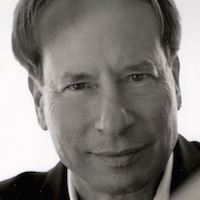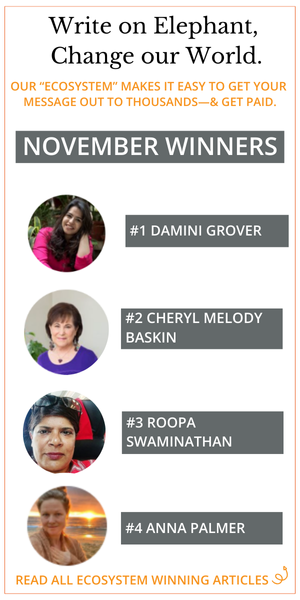Originally, our thoughts came from gratitude, because we felt blessed, loved and embraced by Mother Earth.
We weren’t just living on Earth; we were embedded in and of the Earth—participating in the renewal of cycles as they manifested in the movements of the sun, the rain and snow; the migrations of animals; the return of berries and seeds, fruits and nuts. We came from Earth and, in death, returned to her. All was part of the circle of life, known as the Sacred Hoop.
Our ancient thinking connected us to Earth, but today, our thought seemingly divides us, not only from Earth, but from other people, and even sometimes from ourselves. It is not Earth that has changed so much, but our thinking.
In the past 500 years, Western science has made enormous strides in technological advancement, all of which were predicated upon concurrent development of new types of thought—specifically, analytical, linear and critical thinking. While these aspects of thought were rightly valued, they inadvertently distanced us from nature even as we advanced our knowledge about the natural world.
Nature was once believed to be the source of our consciousness. But when we began to see the world as separate and outside of us, this shifted, and we reframed thought as a wholly intra-psychic phenomenon. We began to imagine that only humans could think and have language, which led us to consider humans to be transcendent and superior to the rest of creation. It helped us rationalize the usurping of more and more of the natural world for ourselves.
Today, we imagine abstract thinking as the only thought there is. Other aspects of thought have been cast out, renamed and demoted: they are now called instinct, feeling, emotion and intuition—all of which are considered inferior to rational, abstract cognition. This is a tragic mistake. Feelings, instincts and emotions are all part of a continuum of unfolding consciousness, and, significantly, they all serve to connect us to nature. The natural world unfolds like a plant grows, from seed, to root, bud and fruit. Our thinking could mature in the same way, if we allowed our gut instincts to lead to a heart knowing, and later unfold into an intellectual understanding.
All that happens when we imagine ourselves as transcendent from nature is that we despoil our own environment and remake nature for solely human concerns. We have remade land into real estate, the rhythms of the Earth into time, and time into money. All of the world’s beauty is in the process of becoming monetized, in service of an insatiable quest for growth. Only recently have we begun to question the folly of uncontrollable growth on a finite planet.
Clearly, we have to change, but change will not be possible unless we transform our thinking. We need not go back to how we used to think, or to that way alone—but we can reclaim and enlarge our definition of thinking. We must re-member to think as Nature thinks in the original sense of the word, which is to become whole again, the opposite of being dismembered. I call this mode of being Original Thinking, composed of 13 qualities or aspects that I will now discuss.
Original Thinking is thankful.
The origin of thinking is thanking. Both “thinking” and “thanking” came into English from the proto-Germanic pankaz, the root of “gratitude” and “thought.” In at least seven languages, including Old Saxon, German, Norse, Danish, Frisian and Dutch, there was a connection between thanking (or giving thanks) and thinking. How is that possible? It could be because, originally, all our thoughts were prayers. We thought/prayed from a sense of gratitude and blessing for All There Is, rather than from lack for what we didn’t have.
It is only when we learned to manipulate the Earth for our purposes that we came to see the world as somehow insufficient. For the world to be whole again, we must change our thinking. In fact, we must thank before we think. Imagine that: thinking as thanking. And the more you “thank” about it, the happier you are likely to become.
Original Thinking begins in wholeness.
Original Thinking is thinking that begins in wholeness, in gratitude for all there is. Thinking that begins in wholeness remains in wholeness, even if it employs abstract thought for limited purposes. We are always in relationship with the whole.
Original Thinking comes from particular places (origins).
Original Thinking comes from particular places which contain particular vibratory frequencies and inspire particular thoughts. If we attune to a place, we become aware of a deep knowing that is emergent from the place we are in. Our thoughts come from the place we are in whether we are aware of it or not.
I am composing this in Taos, New Mexico, a place I come frequently to write. I am attracted to Taos not just because it is surrounded by mountains and wide open spaces, but also because the land dives downward, deep into a river gorge 250 meters below the high desert plateau. When I am here, my thoughts expand in all directions, just as the land goes up, down and across. I also feel an expanded sense of time, because canyons and mountains are portals, presenting eons of time at once.
Original Thinking is not new or old, but both.
If we accept the premise of our thoughts originating from a place, and the land as a multidimensional inlet to time, a new (original) awareness may arise. We become liberated from seeing time as linear. Time becomes an open doorway between past, present and future; the past and future are braided together in an alive presence of the moment.
Original Thinking is in sync with the rhythms and cycles of nature.
There is a pulse and rhythm to nature and we humans are capable of synchronizing with it because human beings also progress in cycles, even if we are not aware of it. The human life cycle is not so different than that of a plant; we too are born in darkness; grow upward toward the light, and produce fruit, only the fruit of our lives is the wisdom that we hopefully pass onto future generations.
For millennia, human traditions and ceremonies were based on the awareness of life as a circle, and many traditions still practice this. The circle of life helps us act in harmony with all things as they arise and fall in their proper season.
Original Thinking is out-of-the-box thinking.
Linear thinking sees reality as partitioned into separate things, categories, and time blocks. Original thinking is outside the box of linear fragmentation, seeing beyond and across separations, categories, and disciplines. It is wholistic, meta-paradigmatic and timeless, connecting old and new in original and creative combinations of thought.
Original thinking looks for the pattern that connects
In the spirit of the ancient natural philosophers and moderns, such as, Gregory Bateson, original thinking looks for the pattern that connects. It sees the world as all related. This approach naturally lends itself to seeing partnerships and alliances in nature rather than separation and competition. It is an ongoing process—never completed but ever widening in scope.
Original Thinking embraces paradox and change.
Original Thinking is both/and rather than either/or thinking. What appears to be a polarized end of a dichotomy is really a complementary balancing side and that this can change over time. As the late Navajo elder Grandfather Leon Secatero once said, “In time, a negative becomes a positive and a positive becomes a negative.”
Original Thinking includes feeling, instinct and heartfelt emotion.
Original Thinking is a total movement of thought that originates in nature and enters the body through the feet, gut or heart, and only later is understood by the head. To think originally is to accept instinct, emotion and feeling as part of the continuum of thought.
Original Thinking is a form of participatory consciousness.
Original Thinking revives the old meaning of consciousness, which is “knowing with” rather than in separation. It is a form of participatory consciousness or thinking together that is very creative. It is not “group think” as in mindlessly following, but an active form of group knowledge construction and collaborative problem solving.
Original Thinking is beautiful.
Original Thinking is beautiful because it brings human thought in harmony and balance with the thought of all creation. Ironically, this form of beautiful thinking is similar to the roots of rational thought—rational coming from ratio—or the relationship between things. In the right proportions (what the ancient Greeks called divine proportion or the golden ratio) the relationship between things is beautiful. Ultimately, beauty can be a path of life, what in Navajo is called sa’ah naaghai bik’eh hozhoon, or the Beauty way. Living in beauty begins with and is nourished by harmonious and loving thoughts.
Original Thinking is radical.
Original Thinking is radical in the original sense of going to the roots. It is about asking the right questions to get to the bottom of things and is of great depth and dimension.
Original Thinking is wise.
Original Thinking is wise, and wisdom is timeless, appropriate for any era. But what is wisdom? It is born of real experience, but not in the way we commonly assume. It is not garnered through the accumulation of past results, for if it could be, then computers would be wise.
The people I consider wise are present in the moment. They become wise through an attitude of open engagement. It is not the mere accumulation of life experience that makes them wise, but the way they have experienced life. A wise person trusts their intuition. They may have surprisingly analytical minds when needed, but they do not rely solely upon rational thought. They allow for the mysterious to augment their moment-to-moment awareness—and it is this quality that makes them wise. A wise person has wisdom vibrating through every aspect of their being; you can feel it just by being in their presence.
In sum, the way we think determines how we see the world. It is not that one mode of thinking is right or wrong, but we can learn to perceive in a deeper, wider and wiser way, and this I call original thinking. It is essential we expand our thinking to this new—and simultaneously old—awareness.
The way we think must change if we ever hope to solve a host of seemingly intractable problems: climate change; overpopulation; food security; healthy water, air, and soil; to name a few. We have created these problems for ourselves by thinking in partial, fragmented ways.
What the world needs now is original thinking, or thought that is timeless and whole. We must remember the source of our own consciousness: nature, which is whole. Nature is the original teacher. We cannot improve upon her. We can be grateful for the immense bounty she provides, and for all our relations in which we share this planet. And we can give thanks for the blessing of being alive, and remember that thinking is thanking in all our thoughts and deeds.
Love elephant and want to go steady?
Sign up for our (curated) daily and weekly newsletters!
Author: Glenn Aparicio Parry
Editor: Travis May
Photo: Big Stock


 Share on bsky
Share on bsky





Read 0 comments and reply